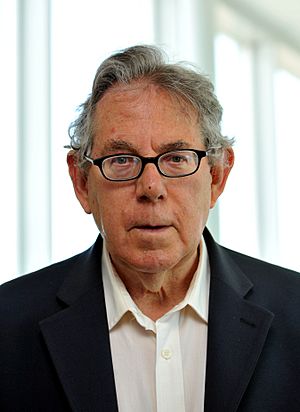Paul J. Crutzen facts for kids
Quick facts for kids
Paul J. Crutzen
|
|
|---|---|

Crutzen in 2010
|
|
| Born |
Paul Jozef Crutzen
3 December 1933 Amsterdam, Netherlands
|
| Died | 28 January 2021 (aged 87) Mainz, Germany
|
| Alma mater | University of Stockholm |
| Known for |
|
| Awards |
|
| Scientific career | |
| Fields | |
| Institutions |
|
| Thesis | Determination of parameters appearing in the "dry" and the "wet" photochemical theories for ozone in the stratosphere. (1968) |
| Doctoral advisor |
|
| Doctoral students |
|
Paul Jozef Crutzen (born December 3, 1933 – died January 28, 2021) was a Dutch scientist. He studied the atmosphere and its chemistry. In 1995, he won the Nobel Prize in Chemistry. This award was for his important work on how ozone forms and breaks down in the atmosphere.
Crutzen also helped make the word Anthropocene popular. This term describes a new time in Earth's history. It's when human actions have a huge effect on our planet. He was also one of the first scientists to talk about "nuclear winter." This idea describes how a lot of smoke and pollution in the air could change the climate.
Contents
Early Life and School
Paul Crutzen was born in Amsterdam, Netherlands. This was in 1933. When he started elementary school in 1940, Germany invaded the Netherlands. The war caused many delays and school changes for him.
After elementary school, he went to a "Higher Citizens School" in 1946. There, he learned to speak French, English, and German very well. He also focused on science subjects. He finished this school in 1951. Later, he studied Civil Engineering at a technical school. He then completed his military service. In 1958, he moved with his family to Sweden.
Studying the Atmosphere
Crutzen spent most of his career studying atmospheric chemistry. This is the science of what the air around us is made of. He is most famous for his work on the ozone layer. The ozone layer protects Earth from harmful sunlight.
In 1970, he showed that a gas called nitrous oxide (N2O) could affect the ozone layer. This gas comes from soil bacteria. Crutzen explained that nitrous oxide can travel high into the atmosphere. There, it changes into another gas that can harm the ozone. He thought that using more fertilizers might increase this gas. This meant human actions could affect the ozone layer.
Crutzen worked at the Max Planck Institute for Chemistry in Germany. He also worked at the Scripps Institution of Oceanography in the United States. He was a professor at Stockholm University in Sweden.
The Anthropocene Idea
One of Crutzen's big ideas was the Anthropocene. In 2000, he and another scientist, Eugene F. Stoermer, suggested this term. They wanted to show how much humans have changed the Earth. The Anthropocene is a proposed new period in Earth's history. It highlights that human activities are now the main force shaping our planet's geology and environment.
Geoengineering: A Big Idea
Crutzen believed that efforts to reduce greenhouse gases were not enough. He thought we might need a "plan B" if global warming got out of control. This plan B is called climate engineering or geoengineering.
He suggested a way to cool the Earth artificially. This would involve releasing tiny particles, like sulfur, into the upper atmosphere. These particles would reflect sunlight back into space. This could help reduce some of the warming caused by human pollution.
Nuclear Winter
Crutzen was also a key scientist in developing the idea of nuclear winter. In 1982, he wrote a paper with John W. Birks about this. They thought about what would happen if many large fires started. These fires could be from forests, cities, or oil storage. They believed the smoke would rise high into the atmosphere.
This black smoke would block sunlight. It could cause darkness and very cold temperatures on Earth's surface. It would also heat the air higher up. These changes could create strange weather and climate conditions. Such conditions could make it hard to grow food for many people.
Awards and Honours
Paul Crutzen received many awards for his scientific work. The most famous was the Nobel Prize in Chemistry in 1995. He shared it with Mario J. Molina and F. Sherwood Rowland. They won for their discoveries about the ozone layer.
Some of his other awards include:
- 1989: Tyler Prize for Environmental Achievement
- 1991: Volvo Environment Prize
- 2006: Elected a Foreign Member of the Royal Society in the UK
- 2019: Lomonosov Gold Medal
Personal Life
Paul Crutzen married Terttu Soininen in 1958. They had two daughters. Their first daughter, Ilona, was born in 1958. Their second daughter, Sylvia, was born in 1964.
Paul Crutzen passed away on January 28, 2021, at the age of 87.
See also
 In Spanish: Paul J. Crutzen para niños
In Spanish: Paul J. Crutzen para niños

